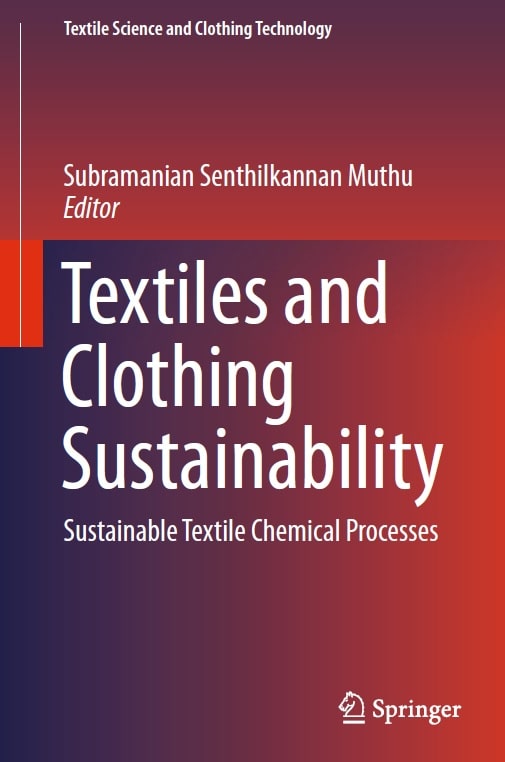
Contents
Ecological and Sustainable Natural Dyes . . . . . . . . . . . . . . . . . . . . . . . . . 1
Nigar Merdan, Seyda Eyupoglu and Mujgan Nayci Duman
Challenges in Sustainable Wet Processing of Textiles . . . . . . . . . . . . . . . 43
Sujata Saxena, A.S.M. Raja and A. Arputharaj
Anthraquinone-based Natural Colourants from Insects . . . . . . . . . . . . . . 81
Shahid-ul-Islam and F. Mohammad
Sustainable Dyeing and Finishing of Textiles Using Natural
Ingredients and Water-Free Technologies. . . . . . . . . . . . . . . . . . . . . . . . . 99
Kartick K. Samanta, S. Basak and S.K. Chattopadhyay
Ecological and Sustainable Natural Dyes
Nigar Merdan, Seyda Eyupoglu and Mujgan Nayci Duman
Abstract Since prehistoric times, natural dyes have been used to color of natural fibers such as cotton, wool, and silk as well as fur and leather. The use of natural dyes declined with the discovery of synthetic dyes in 1856. However, the increase in environmental consciousness created an upsurge in the interest in natural dyes. Nowadays, the use of natural dyes becomes common in food, cosmetic, pharmacology, and textile industry. In this study, natural dyes are investigated in all respects such as history, origin, chemical structure, advantages, and limitations. Furthermore, in natural dyeing, the innovative technologies are researched.
Keywords Natural dyes _ Sustainability _ Ecological _ Innovative technologies
1 Introduction
The use of natural dyes trace back to ancient times. Through the ages, textile materials, leather, and foods have been dyed with natural dyes obtained from herbal and animal sources. Generally, natural dyes are provided from roots, steams, leaves, flowers, fruits of the plants, organism of the crustaceans, marine insects, snails, and cochineals. We want to explain that the synthetic dyes were discoverde and used because of natural dyes limitations. In textile industry, to synthetic dye stuff and pigments widely used because of their various colors, better color fastness properties, and low prices. However, the overlooked issue associated with synthetic dyes is that synthetic dyes are toxic, carcinogenic, and non-biodegradable. For these reasons, especially textile industry, the use of natural dyes is popular in our times. As far as the textile industry is concerned, dyeing and finishing process is an essential step so as to gain esthetic properties to textile materials. The dyeing of textile materials is carried out in an aqueous solution at high temperature. For this reason, the dyeing process of textile material demand high consumption of energy, water, dyes, and textile auxiliaries. Furthermore, the dyeing process causes environmental pollution so as to have dyes and textile auxiliaries [1]. Recently, the dyeing industry has been seeking for alternative process in order to reduce toxic effluents and environmental pollution. Therefore, the interest in natural dyes in textile industry has risen inasmuch as natural dyes are biodegradable, non-toxic, and eco-friendly [2–5].
In recent years, the increase use of synthetic dyes in textile, paper, paint, cosmetic, food, and pharmaceutical industries has caused to increase interest in the field of dye wastewater treatment for the global society. The degradable of synthetic dyes is very difficult and these dyes generally stable to light, oxidizing, and heat owing to their complex aromatic structure. Furthermore, another problem about synthetic dyes should be noted that these dyes have toxic, mutagenic, or carcinogenic compounds, they will have a huge impact on aquatic ecosystem and human health. Therefore, in the use of synthetic dyes, effective purification of wastewater becomes very essential. Nowadays, many techniques are used to purify of the wastewater such as membrane separation, ion exchange, flocculation, chemical oxidation, electrolysis, filtration, microbiological degradation, and photocatalysis degradation. Although these purification methods are low cost, high efficiency, and low energy consumption, the use of natural dyes eliminates the purification process of wastewater [6].
In this study, the use of natural dyes in textile dyeing process was investigated. Furthermore, chemical structure, origins, dyeing methods, advantages, disadvantages, toxicological, dermatologic, and antimicrobial effects and future of natural dyeing were researched.
2 Natural Dyes
The term “natural dyeing” has come to be used to refer to obtaining dyes from substances found in nature and to dyeing of various surfaces these dyes. The history of natural dyeing dates back to ancient times in the world.
3 History of Natural Dyes
In ancient times, humans used some substrates such as stones, soil, plants, and insects to dye textile materials. However, the interest in plants has increased in natural dyeing as the varieties of stones, soil, and insects are limited. Humans have begun, furthermore, to use flowers, leaves, and fruits of plants in dyeing acknowledging the variety of plant colors. As a result of archeological excavations, lots of substances have been used as natural dyes in order to dye textile materials.
• Indigo-dyed fabrics from the archeological finds, which go back to 3500 BC, were found to include indigo dye obtained from indigo plants of the genus Indigofera.
• In 3000 BC, madder (Rubia tinctorium) was used to dye purses produced from cotton fibers.
• The clay tablets, which date back to around 3000 BC in ancient Mesopotamia, were also found to include the dye derived from the kermes which yields the red color. Polish kermes and madder are, on the other hand, used in the samples of Pazyryk carpet, which are considered to be the oldest known carpet in the world and date back to 500 BC.
• The use of violet color obtained from sea snail has begun between the dates of 1800s BC and 1600s BC in the Mediterranean Seaside.
• In India, lac beetles were used to obtain red color in 1500 BCs.
• The use of cochineal beetles in dyeing dates back to 1000s BC in Mexico. Then, the dyeing with cochineal beetles has become widespread Europe and Asia.
